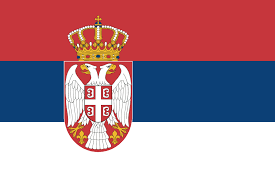Serbia flag Colors Code hex, png svg
History of the Serbian Flag
The flag of Serbia has a rich history and has undergone several changes over the centuries. The current national flag was officially adopted on November 11, 2010, although its design has been used in various forms since the early 19th century.
- Early History: The first flags that represented Serbian states date back to medieval times. These flags often featured religious symbols, such as the Christian cross.
- 19th Century: During the First Serbian Uprising (1804-1813) against Ottoman rule, the Serbian revolutionary forces used a red-blue-white tricolor flag. This tricolor design was inspired by the Russian flag, as Russia was seen as a protector of Orthodox Christians in the Balkans.
- Kingdom of Serbia (1882-1918): The flag of the Kingdom of Serbia was a horizontal tricolor of red, blue, and white. This design was based on the flag used during the uprisings but became more standardized.
- Yugoslav Period (1918-1992): When Serbia became part of the Kingdom of Serbs, Croats, and Slovenes (later Yugoslavia), the Serbian tricolor was incorporated into the Yugoslav flag. After World War II, the Socialist Federal Republic of Yugoslavia adopted a new flag featuring a red star, but the Serbian tricolor continued to be used within the republic.
- Post-Yugoslav Period: After the breakup of Yugoslavia in the early 1990s, Serbia used the traditional red-blue-white tricolor as its national flag. Minor modifications were made, including the addition of the Serbian coat of arms.
- Current Flag (2010-present): The current flag of Serbia was officially adopted on November 11, 2010. It retains the traditional red-blue-white tricolor but includes the Serbian coat of arms on the left side.
Colors and Their Meaning
- Red: The red color on the Serbian flag represents the blood shed in the struggle for freedom and independence. It is a symbol of the bravery and sacrifice of the Serbian people throughout their history.
- Blue: The blue color symbolizes freedom and hope for the future. It reflects the Serbian people’s aspirations for peace and stability.
- White: The white color represents purity and honesty. It signifies the moral values and integrity of the Serbian nation.
Coat of Arms
The flag features the Serbian coat of arms, which includes:
- Double-headed Eagle: This symbol, derived from Byzantine heraldry, represents the historical and cultural connection between Serbia and the Byzantine Empire.
- Crown: The crown on top of the double-headed eagle signifies the sovereignty and royal heritage of Serbia.
- Cross and Fire Steels (ocila): The cross and the four fire steels (ocila) in each corner are ancient Serbian symbols that represent the motto “Only Unity Saves the Serbs.”
Conclusion
The flag of Serbia is a powerful symbol of national identity, reflecting the country’s history, cultural heritage, and the values of its people. The red, blue, and white colors have deep historical and symbolic meanings, representing bravery, freedom, hope, purity, and honesty. The inclusion of the coat of arms further emphasizes Serbia’s rich historical and cultural legacy.
Guess the Flags Quiz
Sharing is caring 🤗

National Symbols 👇
- 🏁 National Flags
- 🦁 National Animals
- 🐦 National Birds
- 🌻 National Flowers
- 🌴 National Trees
- 🥭 National Fruits
- 🍹 National Drinks
- 👴 National Founders
- ☘️ National Emblems
- 🍲 National Dishes
- 🏛️ National Monuments
- ✍️ National Poets
- 🕌 National Mausoleums
- 🎺 National Instruments
- 🦸 National Heroes
- 📆 National Days

